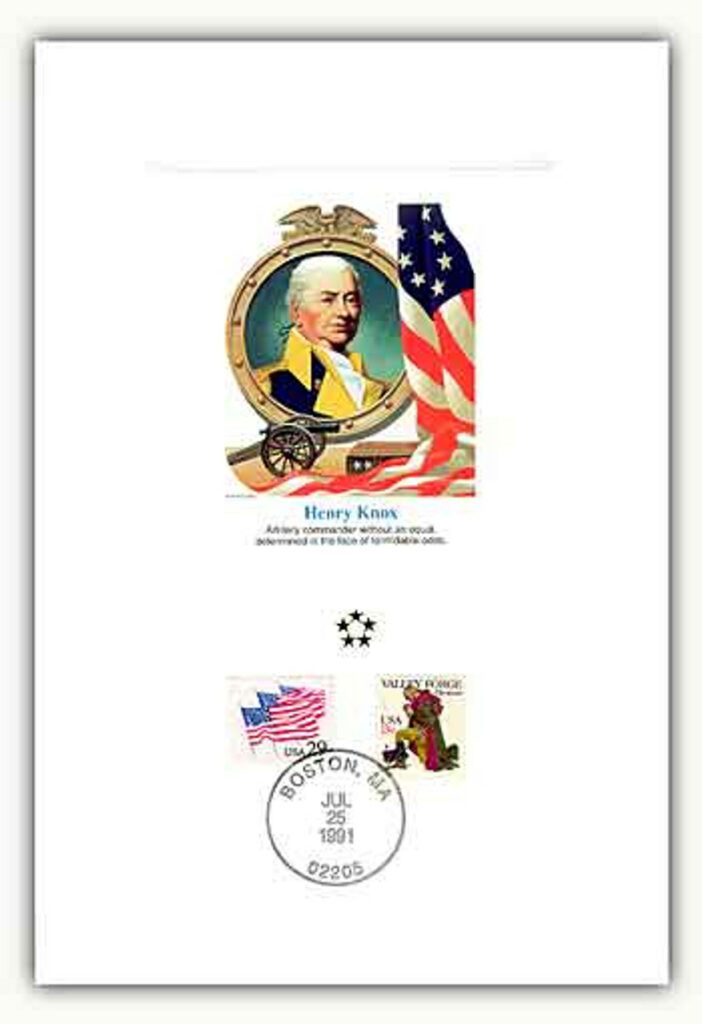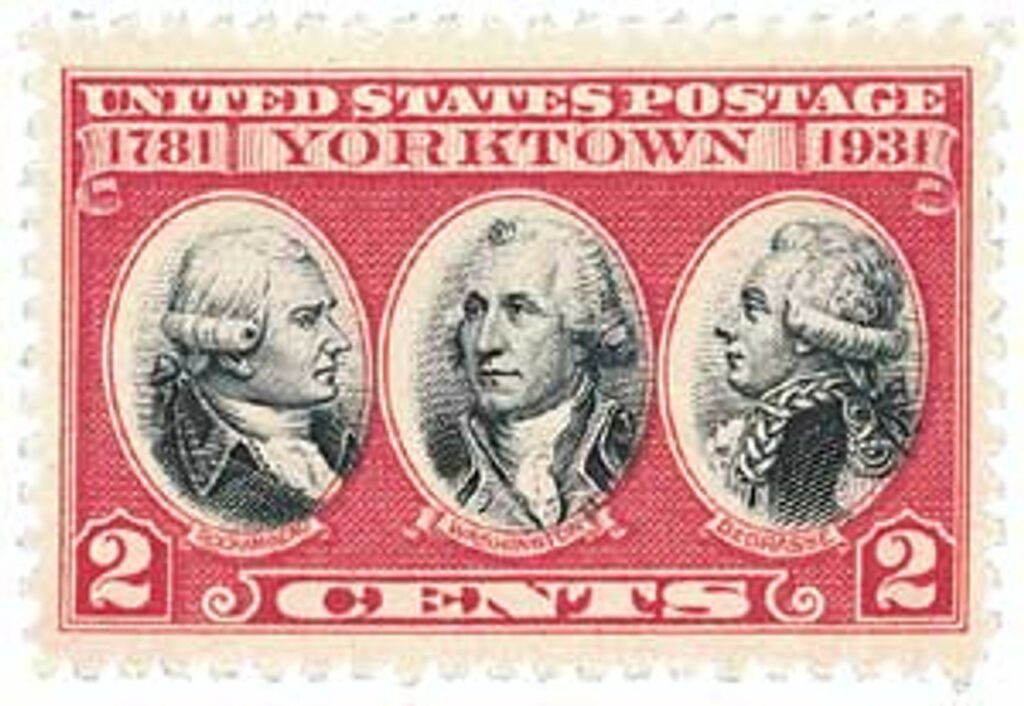On October 25, 1806, Henry Knox died near Thomaston, Massachusetts (present-day Maine).
Henry Knox was born on July 25, 1750, in Boston, Massachusetts. After his father abandoned the family, Henry, the family’s oldest son, left school and took a job as a clerk in a bookstore. The shop’s owner, Nicholas Bowes, became a father figure to Knox. But Knox was also caught up in Boston’s street gangs, becoming one of his neighborhood’s best fighters. Then one day he witnessed an impressive military demonstration and decided to join his local artillery company at age 18.
In 1770, Knox witnessed the Boston Massacre, though he had tried to end it peacefully. The following year, he opened his own bookshop, the London Book Store. Having had little education as a child, Knox used his store to teach himself a number of things. He soon developed a deep interest in military history, reading everything he could find about military subjects.
Then in 1772 cofounded the Boston Grenadier Corps, of which he served as second in command. During this time, Knox supported the actions of the Sons of Liberty. While it’s unknown if he participated in the Boston Tea Party, he did serve as a guard for one of the ships, ensuring the tea wasn’t unloaded before the uprising.
Knox married Lucy Flucker in 1774, the daughter of Boston Loyalists who attempted to get Knox on their side. When the Battles of Lexington and Concord broke out the following year, Knox and his wife snuck out of Boston. Knox then joined the local militia in besieging the city, where his bookshop was looted and destroyed. Working under General Artemas Ward, Knox developed fortifications for the city and then oversaw the artillery fire at the Battle of Bunker Hill.
General George Washington arrived in July 1775 to assume command of the army and was impressed by Knox’s work. The two men became good friends and worked together to develop the Continental Army. Knox hadn’t received an official military commission, but John Adams convinced the Second Continental Congress to appoint him a colonel in the army’s artillery regiment.
While Boston was still under siege, Knox had an idea. If they could get the cannons from recently captured Forts Ticonderoga and Crown Point to Boston, they could turn the tide of the battle. Washington supported his idea and sent him on the mission, which became known as Knox’s “noble train of artillery.” Knox and a team of engineers then transported 60 tons of artillery from Northern New York to Boston in the middle of winter. One historian called the move “one of the most stupendous feats of logistics” of the war. With those cannons in place, Washington forced the British to surrender the city.
As Washington’s right-hand man, Knox joined the commander-in-chief on most of his campaigns and was involved in most of the war’s major battles. He was nearly captured after the British invaded Manhattan. In December 1776, Knox directed the Christmas night crossing of the Delaware River that preceded the Battle of Trenton. He then oversaw the return of those men and hundreds of prisoners. For his efforts, Knox was promoted to brigadier general and given command of five artillery regiments.
That winter, Knox went back to Massachusetts to improve the manufacture of artillery and raise another battalion. He went on to participate in the battles at Brandywine, Germantown, and Monmouth before forming the army’s first artillery and officer training school (often considered the precursor to West Point). He then joined in the Siege of Yorktown, where he directed artillery. In 1782, Knox became the army’s youngest major general and was tasked with negotiating prisoner exchanges with the British (which ultimately failed). When Washington stepped down in 1783, Knox took over as the senior commander of the Army. He formed the Society of the Cincinnati, a fraternity of Revolutionary War officers, and developed plans for a peacetime army.
Knox was considered for the post of Secretary at War, but when Congress tried to create a standing militia as a peacetime army, he resigned. Knox returned to Massachusetts and settled in present-day Maine. Then, in 1785, Knox was appointed Secretary at War. The War Department was small but Knox was authorized to raise a 700-man army. When Shays’ Rebellion broke out in 1786, it made the weaknesses of the military and the Articles of Confederation obvious, leading to the Constitutional Convention. Knox sent George Washington a proposal for a new government (similar to what was eventually adopted). He also encouraged Washington to attend the convention, calling him the “Father of Your Country,” possibly one of the first instances of this phrase being applied to Washington.
Knox promoted the new constitution and under it was made the first Secretary of War of the new War Department. In this role, Knox was responsible for maintaining and managing the Army and the Navy, until the Navy Department was established in 1798. He also saw that new coastal fortifications were established, demanded better training of the local militias, and settled disputes in the western part of the infant nation.
Knox retired from government work in January 1795 to spend more time with his family. In his final years, he embarked on a number of business ventures including real estate, cattle farming, ship building, and brick making. In 1806, Knox swallowed a chicken bone which caught in his throat and became infected. Three days later, on October 25, 1806, he died and was later buried with full military honors.
Numerous sites have been named after Knox, including the city of Knoxville, Tennessee. Counties in nine states have been named in his honor, and two military forts were also named for him.
Click here to see what else happened on This Day in History.






One could truly bask at the profound impact our forefathers had made during the early days of a determined nation. May Henry Knox rest in peace.
Godspeed
An excellent summary of a historical but often forgotten revolutionary war hero.
Good article. Dad blasted chicken bones anyhow!
Most interesting piece of american history,not as well known as Washington or jefferson but he was that important! BRAVO KNOX!
What a different world we live in today. What a different country this is. We are land full of personal grievances and factions that want what we want – no matter the cost to others, nor the cost of the country. Yet, here is a history of a young man who grew up under very adverse circumstances but who made great choices and accepted responsibility for his life and turned that life into a marvelous creation and gift for this country.
Lets not have too rosy a view of the founders of this nation. Certainly, the Founding Fathers are deserving of respect, but they too had personal grievances and were divided into factions that did not agree with each other, sometimes violently. There were shouting matches, fist fights, and duels over the issues of the day. Several delegates walked out of the Constitutional Convention because they did not agree with what was being done, and three attendees refused to sign the final document. These were flesh and blood people who were probably not so different from people today.
Jim – your comments can only make sense if you’re talking about white men. I don’t think American Indians, the Blacks and women could possibly join in your fantasy about the past.
The above comments are totally irrelevant, Henry Knox is an American hero. More young people should learn about him
DK-You are mostly correct, but the simple truth is that some of out predecessors made good choices and some bad. The facts are what they were. There are always choices and decisions to be made and Knox made mostly good ones. Examining the overall morality of the days does not change what was done, good or bad. We need only work to improve what we have.
Dom, what’s with the attack. It’s history, not fantasy. Yes, there were peoples treated unequally but I think we have advanced as a nation.
As for Knox, I have never heard of him so thanks for the history lesson.
the article is about history and NOT political correctness. Leave your troll comments elsewhere
Another interesting write up. Thank you.
I knew of General Knox but did not know his difficult early life . So often these abandoned families made it necessary for the oldest son to become head of the household as best they could. I had forgotten about his train of artillery. Sad about the chicken bone and subsequent infection.
Henry Knox was NOT the eldest son in his family. Henry Knox was the 7th son born our of 10 sons to William Knox and Mary (nee Campbell) Knox.
Great story about Henry Knox and new piece of history for me.
I got an additional bonus today with a good early morning laugh with, “Knox married Lucy Flucker in 1774”. What a name!
Another person that our history books neglect to mention. Good work. keep it up.
Oh come on, Lloyd, Knox is mentioned in the history books. Even in not, not everyone can be mentioned, or the books would be thousands of pages long.
Knew the name and now I know the story!
Thanks!
Of all things, a chicken bone. The paradox is too much as Knox was anything but chicken. From a hell-raiser to Secretary of War. Like they say, war is hell. Hope we can take a little humor today.
Back on a philatelic note, many covers were created during the reenactment of the “noble train of artillery” as part of the nation’s bicentennial. It would have been nice to illustrate one of them with the article.
Very interesting. I didn’t know of the history. Always great to learn something new. Thanks!
A day late but not a dollar short. I believe that Henry Knox was given the commission as a Colonel in the Artillery because of the feat of the “Noble Train” not before it. That trek was 300 miles up and down hills in snow covered country. Henry convinced congress to build two strategically located arsenals which not only made the cannons used in the war but had attached chemical factories to make the powder. He was a young man ahead of his time in visualizing the future but in the right place to aid Washington.
I’ve read a great biography of H. Knox and the trek in the winter to bring the cannon to NYC was even worse than this summary hinted at. His efforts later in life also qualify him as a genuine hero.
There is a famous WW2 Navy admiral named Flucker. He was the most decorated submarine captain in that war. Wonder if they were related?
No, they are not related. The man you are referring to is Eugene Bennett Fluckey, no relation. However, Henry Knox and Lucy Flucker Knox’ grandson, Henry Knox Thatcher, was indeed a military man. Henry Knox Thatcher served as rear admiral in the Navy during the United States Civil War.
Henry Knox was the 7th son of 10 sons born to William Knox and Mary nee Campbell Knox.